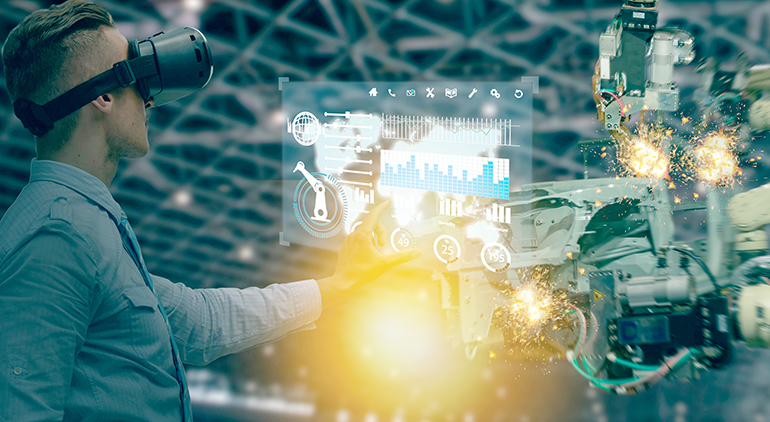The landscape of professional training has evolved dramatically over the past decade. Traditional methods of workforce training—while effective in certain contexts—often fall short in industries requiring hands-on, immersive experiences.
Virtual Reality (VR): a groundbreaking tool that is revolutionizing how employees learn, practice, and refine their skills. By offering realistic, interactive environments, VR simulations are bridging the gap between theoretical knowledge and practical application, ensuring a more skilled and confident workforce.
Why VR is Perfect for Workforce Training
Virtual Reality combines technology with real-world scenarios, allowing learners to experience situations that would otherwise be expensive, risky, or logistically challenging. Imagine a construction worker mastering the operation of heavy machinery without any risk of injury, or a surgeon practicing a delicate procedure without putting a patient’s life at stake.
VR enables employees to engage with their training actively, which is proven to enhance retention and skill acquisition compared to passive learning methods.
Moreover, VR training can be personalized to suit an individual’s learning pace and style. This customization makes it an invaluable tool for industries that demand precision and expertise.
Key Advantages of VR Simulations for Skill Development
- Realistic Learning Environments
VR creates hyper-realistic scenarios that replicate workplace challenges. For instance, retail staff can practice managing customer interactions, while pilots can navigate complex simulations of adverse weather conditions. Such realism prepares employees for actual challenges, improving their ability to perform under pressure.
- Cost-Effective and Scalable Solutions
Training new employees or upskilling existing ones often incurs high costs, particularly in industries like healthcare, manufacturing, or aviation. With VR, companies can significantly reduce these expenses by providing virtual scenarios that replace physical training setups. Furthermore, VR modules are reusable and scalable, ensuring consistent training across multiple teams and locations.
- Enhanced Safety for High-Risk Jobs
Jobs in industries such as oil and gas, mining, or defense involve significant risks. VR simulations allow employees to gain hands-on experience in managing emergencies or operating hazardous equipment—all within a safe, controlled environment. - Immediate Feedback and Analytics
A standout feature of VR training is the ability to provide real-time feedback. Learners can identify areas of improvement instantly, and employers can use analytics to track progress and assess overall performance.
Related post: 3D Animation for Product Launch Campaigns
How VR Simulations Work
The core of VR training lies in its immersive technology. Users wear VR headsets equipped with motion sensors and haptic feedback to interact with digital environments. These environments can range from hospital operating rooms to high-rise construction sites, depending on the specific industry.
Training modules are designed to mimic real-world tasks. For example, a technician working in a factory may use VR to troubleshoot a machine, while receiving guidance and feedback in real-time. This interactivity ensures that employees are not only learning but also practicing critical thinking and decision-making skills.
Applications Across Industries
Healthcare
In healthcare, VR simulations are transforming the way medical professionals acquire and refine skills. From diagnosing complex diseases to performing surgeries, VR provides a risk-free platform for medical training. Surgeons can practice intricate procedures repeatedly until they achieve perfection, enhancing patient safety and outcomes.
Aviation
VR has long been a staple in aviation training, offering pilots lifelike simulations of various flying conditions. These simulations help trainees master complex scenarios, such as emergency landings or severe turbulence, ensuring they are prepared for any eventuality.
Manufacturing and Industrial Training
In manufacturing, VR is utilized for equipment operation, assembly line tasks, and even compliance training. Workers can familiarize themselves with machinery without any risk to their safety or the company’s resources. After 200 words, it’s worth noting that enterprise augmented reality is also becoming a popular choice for complementing VR solutions in industrial training.
Retail and Customer Service
Retail employees benefit from VR scenarios that teach customer interaction, inventory management, and even store layout optimization. This interactive approach not only boosts efficiency but also improves customer satisfaction.
Defense and Public Safety
For military personnel and emergency responders, VR offers training scenarios ranging from combat simulations to disaster management. By practicing in virtual environments, these professionals can hone their skills and strategies without endangering lives.
The Future of VR in Workforce Training
As technology advances, VR training is becoming more accessible and sophisticated. The integration of Artificial Intelligence (AI) with VR is expected to enhance training further, offering dynamic scenarios that adapt to a learner’s performance. Additionally, industries are exploring hybrid solutions that combine VR with Augmented Reality (AR), enabling on-site training through devices like smart glasses.
Another emerging trend is the gamification of VR training. By incorporating game-like elements such as challenges, rewards, and leaderboards, companies can make learning more engaging and enjoyable, motivating employees to actively participate in upskilling initiatives.
Overcoming Barriers to Adoption
While the benefits of VR training are undeniable, some organizations face challenges in adopting this technology. High initial costs, the need for technical expertise, and employee resistance are common hurdles. However, these barriers are gradually diminishing as VR technology becomes more affordable and user-friendly.
Companies looking to integrate VR into their training programs should start by identifying specific use cases and partnering with experienced providers. For instance, collaborating with a VR solution provider that specializes in creating industry-specific simulations can ensure a smoother implementation process.
Conclusion
Virtual Reality is no longer just a futuristic concept; it’s a practical, transformative tool for workforce training. By offering immersive, cost-effective, and scalable solutions, VR is helping organizations across industries upskill their employees, enhance productivity, and maintain a competitive edge.
Whether it’s enabling surgeons to perform complex procedures, pilots to navigate challenging flights, or factory workers to operate machinery safely, VR simulations are redefining how professionals learn and grow. For businesses aiming to thrive in today’s competitive landscape, investing in VR training is not just an option—it’s a necessity.
The possibilities are endless, and as technology continues to evolve, the role of VR in workforce development will only grow stronger. Now is the time for organizations to embrace this innovative approach and empower their teams with the skills they need to succeed in the modern workplace.






